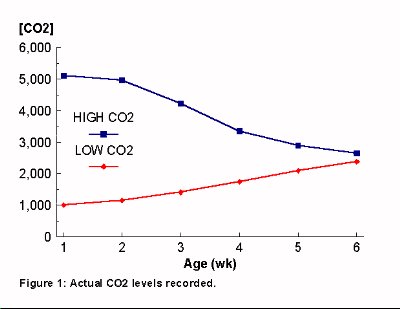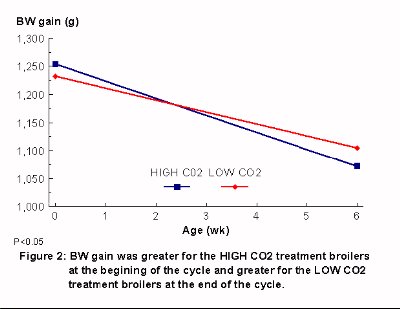| | The problem
The ascites syndrome is a primary cause of death for rapidly growing broiler strains, resulting in economic loss (Huchzermeyer and Ruyck, 1986). The housing environment including factors such as temperature (cold or moderate heat) and air quality (dust concentration, carbon dioxide levels, and oxygen levels) are known to influence the incidence of ascites in broiler chickens. The incidence of ascites has been reported to be greatly increased at altitudes greater than 1300 meters above sea level, presumably because of low oxygen concentration (Hernandez, 1987).
Broilers may not be able to adapt to increased oxygen demands related to environmental stress. If broilers exhibiting lung capacity deficiencies encounter factors that interfere with oxygen transport, breathing ability, or cardiac output, they could develop hypoxia as a primary stimulus of the ascites syndrome (Anthony et al., 1994; Balog et al., 1994). Decreasing the oxygen level to below normal could cause the broiler to become more susceptible to ascites (Jones, 1995). Recent studies show that the volume of oxygen consumed is equal to the carbon dioxide generated by the birds.

Approach
 Carbon Dioxide level. The effects of carbon dioxide concentrations on growth performance and the incidence of ascites were studied in 1200 male broilers. Four pens of birds were subjected to LOW CO2 concentration treatment (600 ppm at wk 0 increasing to 2500 ppm at wk 6) and four pens received HIGH CO2 concentration treatment (6000 ppm at wk 0 decreasing to 2500 ppm at wk 6) (Figure 1). CO2 was controlled by ventilation rates. Carbon Dioxide level. The effects of carbon dioxide concentrations on growth performance and the incidence of ascites were studied in 1200 male broilers. Four pens of birds were subjected to LOW CO2 concentration treatment (600 ppm at wk 0 increasing to 2500 ppm at wk 6) and four pens received HIGH CO2 concentration treatment (6000 ppm at wk 0 decreasing to 2500 ppm at wk 6) (Figure 1). CO2 was controlled by ventilation rates.
Ascites score. At 6 wk of age, all birds were scored for the incidence of ascites syndrome at the processing plant. Hearts were removed and dissected. A cross sectional image of each heart was analyzed to determine the area of the right ventricle (RVA - the right ventricle is the chamber in the heart which pumps blood to the lungs).
Results and Discussion
At 4 wk of age, the broilers subjected to the HIGH CO2 treatment had a greater weight (1297.0 g) than the broilers subjected to the LOW CO2 treatment (1275.9 g). By 6 wk of age, however, the treatments had no effect on body weight. The differences in carbon dioxide concentration change the growth pattern of the broilers. Relatively young broilers, had higher growth rates in the HIGH CO2 treatment than the LOW CO2 treatment, however, after 4 wk of age the LOW CO2 treatment had a higher growth rate, compensating for the differences in body weight between the two treatments by 6 wk of age (Figure 2). This suggests that low concentrations of CO2 may be more beneficial to the birds at the finishing stages in growth cycle.
Total feed consumption was not different between the two treatments. The birds in the LOW CO2 treatment pens did not have a reduced ascitic score than the birds in the HIGH CO2 treatment. The RVA was significantly reduced with the reduced level of CO2, 0.47 cm2 and 0.50 cm2.
I.K. Edeogu, R. H. McGovern, J. J. R. Feddes, M. J. Zuidhof, J. A. Hanson, and F. E. Robinson
Alberta Agriculture Food and Rural Development and University of Alberta
Source: Poultry Research Centre News - Vol. 6 No. 3, December 1997
|
|